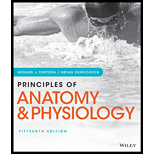
Concept explainers
To review:
The similarities and differences between the blood plasma and interstitial fluid.
Introduction:
Interstitial fluid refers to the fluid that surrounds and bathes the tissue cells in the body of multicellular animals. Plasma is the blood's liquid portion where formed elements such as blood cells are found suspended.
Explanation of Solution
Both plasma and interstitial fluid are found outside the cells and are the major components of the extracellular fluid. Both fluids are of similar composition are and mainly composed of water. Both the fluids lack cells.
The blood plasma and the interstitial fluid differ in the following way:
| Blood plasma | Interstitial fluid |
| Plasma contains higher protein content. | The interstitial fluid contains lower protein content as compared to that in the plasma. |
| Plasma has a higher amount of dissolved oxygen. | Interstitial fluid contains low amount of dissolved oxygen as it is taken up by the cells. |
Thus, the plasma and interstitial fluid are both extracellular fluids with same compositions. The plasma has a higher concentration of protein and dissolved oxygen as compared to interstitial fluid, whereas the interstitial fluid has a higher concentration of carbon dioxide because the cells produce carbon dioxide during energy production and it diffuses out of the cells into the interstitial fluid.
Want to see more full solutions like this?
Chapter 19 Solutions
Principles of Anatomy and Physiology
- What symbolic and cultural behaviors are evident in the archaeological record and associated with Neandertals and anatomically modern humans in Europe beginning around 35,000 yBP (during the Upper Paleolithic)?arrow_forwardDescribe three cranial and postcranial features of Neanderthals skeletons that are likely adaptation to the cold climates of Upper Pleistocene Europe and explain how they are adaptations to a cold climate.arrow_forwardBiology Questionarrow_forward
- ✓ Details Draw a protein that is embedded in a membrane (a transmembrane protein), label the lipid bilayer and the protein. Identify the areas of the lipid bilayer that are hydrophobic and hydrophilic. Draw a membrane with two transporters: a proton pump transporter that uses ATP to generate a proton gradient, and a second transporter that moves glucose by secondary active transport (cartoon-like is ok). It will be important to show protons moving in the correct direction, and that the transporter that is powered by secondary active transport is logically related to the proton pump.arrow_forwarddrawing chemical structure of ATP. please draw in and label whats asked. Thank you.arrow_forwardOutline the negative feedback loop that allows us to maintain a healthy water concentration in our blood. You may use diagram if you wisharrow_forward
- Give examples of fat soluble and non-fat soluble hormonesarrow_forwardJust click view full document and register so you can see the whole document. how do i access this. following from the previous question; https://www.bartleby.com/questions-and-answers/hi-hi-with-this-unit-assessment-psy4406-tp4-report-assessment-material-case-stydu-ms-alecia-moore.-o/5e09906a-5101-4297-a8f7-49449b0bb5a7. on Google this image comes up and i have signed/ payed for the service and unable to access the full document. are you able to copy and past to this response. please see the screenshot from google page. unfortunality its not allowing me attch the image can you please show me the mathmetic calculation/ workout for the reult sectionarrow_forwardIn tabular form, differentiate between reversible and irreversible cell injury.arrow_forward
 Human Biology (MindTap Course List)BiologyISBN:9781305112100Author:Cecie Starr, Beverly McMillanPublisher:Cengage Learning
Human Biology (MindTap Course List)BiologyISBN:9781305112100Author:Cecie Starr, Beverly McMillanPublisher:Cengage Learning





